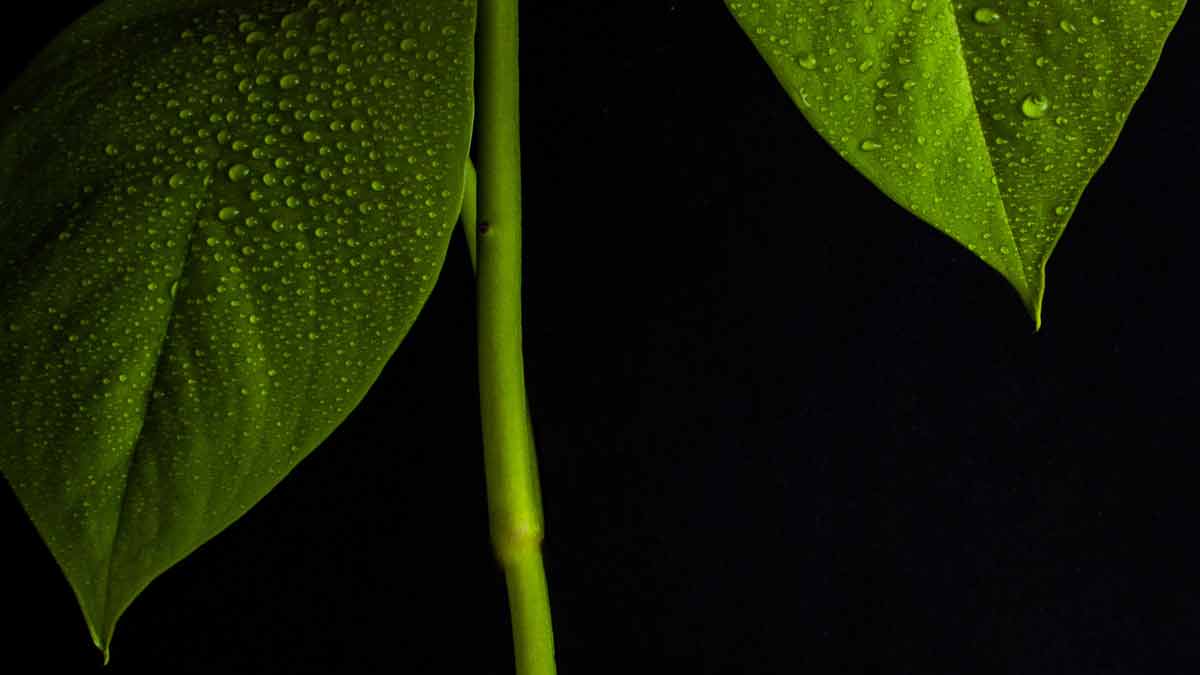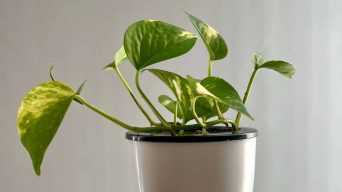Pothos leaves may drip water due to natural processes like transpiration and guttation. Excessive dripping may indicate issues like overwatering, high humidity, poor drainage, root rot, or temperature stress. Adjust watering, improve drainage, and ensure the plant’s environment is suitable to resolve the problem.
Pothos plants are popular houseplants known for their easy care requirements and tolerant nature.
They can grow in various conditions and are often used as indoor plants.
Pothos are generally considered to be low-maintenance plants that are resistant to pests and disease. This makes them a popular choice for many people.
However, pothos leaves may drip water for a variety of reasons, and this can be a cause for concern.
Here, you will find everything you need to know about why your pothos leaves are dripping water and what you can do about it.
Why Do Pothos Leaves Drip Water?
There are a few reasons why pothos leaves may drip water.
The most common reasons are transpiration and guttation.
What Is Transpiration?
Transpiration is the process of water evaporating from a plant’s leaves.
The process of transpiration enables plants to regulate their temperature and get rid of excess water by releasing it through their leaves, allowing them to maintain a healthy balance of moisture and temperature in their environment.
During transpiration, water vapor escapes from the tiny pores, or stomata, on the underside of pothos leaves.
This vapor forms a thin layer of water on the leaves, which then evaporates into the air.
Transpiration is a normal process necessary for the plant to remain healthy.
It is usually more pronounced in hot, dry conditions.
In cooler, more humid conditions, transpiration rates will be lower.
Can Transpiration Be Bad for Pothos Plants?
While transpiration is a normal and necessary process, it can be detrimental to pothos plants if the rate of water loss is too high.
If the plant is losing more water than it is taking in, it will begin to wilt, and the leaves will turn brown and drop off.
Excessive transpiration can be caused by a variety of factors, including:
- High temperatures
- Low humidity
- Dry soil
- Drafts
- Too much light
If you suspect that transpiration is the cause of your pothos leaves dripping water, there are a few things you can do to help the plant.
First, increase the humidity around the plant by misting it regularly or placing it on a pebble tray.
You can also try to increase the moisture in the air by using a humidifier.
Another option is to move the plant to a cooler, more shaded area.
You may need to water the plant more frequently.
What Is Guttation?
Guttation is the process of water droplets forming on the tips or edges of pothos leaves.
It occurs when the plant’s roots take in more water than the leaves can transpire.
The excess water is then forced out of the plant through special pores called hydathodes.
As the water is forced out of the plant, the pressure created by the water vaporizing through the hydathodes causes the plant to lose water from its foliage, resulting in transpiration.
Guttation is a normal process that helps plants regulate their water intake.
It is most common in the morning or evening when the air is cooler and more humid. This is because the plant’s stomata are closed during these times, which reduces the plant’s transpiration rate.
Can Guttation Be Bad for Pothos Plants?
Guttation is generally not harmful to pothos plants.
However, it can be a cause for concern if the plant loses more water than it is taking in.
If this happens, the plant will wilt, and the leaves will turn brown and drop off.
Guttation can also be a sign of over-watering.
If you suspect that guttation is the cause of your devil’s ivy dripping water, there are a few things you can do to help the plant.
First, make sure that you are not watering the plant too frequently.
The best way to water a pothos plant is to let the soil dry out completely between waterings.
Another option is to move the plant to a cooler, more humid environment.
You can also try to increase the humidity around the plant by misting it regularly or placing it on a pebble tray.
You may need to water the plant less frequently.
How to Tell the Difference Between Guttation and Dew
Guttation and dew are often confused because they occur when water droplets form on pothos leaves.
However, there are a few key differences between the two processes.
Dew is the result of condensation.
It occurs when water vapor in the air condenses onto the surface of the pothos leaves.
When the air is cool and humid, rain droplets can form on the surface of the pothos leaves, condensing into dew as the temperature drops and the humidity increases, providing the plant with an extra source of moisture.
Guttation, on the other hand, is the result of the plant’s roots taking in more water than the leaves can transpire.
The excess water is then forced out of the plant through the hydathodes.
Guttation is more likely to occur in the morning or evening when the air is cooler and more humid.
To sum it up, dew is caused by condensation, while guttation is caused by the plant’s roots taking in more water than the leaves can transpire.
If you’re not sure whether the water droplets on your pothos leaves are guttation or dew, there are a few things you can look for.
First, check the temperature and humidity of the environment.
If it’s cool and humid, it’s more likely to be dew.
If it’s warm and dry, it’s more likely to be guttation.
Another way to tell the difference is to look at the time of day.
Guttation is more likely to occur in the morning or evening, while dew is more likely at night.
Finally, you can try to touch the water droplet.
If it’s dew, it will be cool to the touch.
If it’s guttation, it will be warm to the touch.
How to Tell If Your Pothos Plant Dripping Water Is Normal
If your pothos leaves are dripping water, it’s most likely due to one of two reasons: transpiration or guttation.
Transpiration is the process of water vapor escaping from the plant through tiny pores in its leaves.
This usually occurs when the air around the plant is dry and the plant is trying to keep itself hydrated.
Conversely, guttation is when water droplets are exuded from the leaf margins or tips.
This can happen for various reasons but is often a result of the plant taking up too much water.
So, if you see water droplets on your pothos leaves, don’t worry! It’s probably just the plant doing its thing.
However, if you notice that your pothos plant leaf drips water excessively, it could be a sign of a problem.
Possible causes of excessive water dripping from pothos plants include:
1. Overwatering
Overwatering often leads to pothos plants dripping water.
When you water your pothos too frequently, the roots absorb more water than the leaves can release through transpiration. As a result, the plant’s leaves may start to drip water.
To prevent overwatering, water your pothos only when the soil is dry.
2. High Humidity
Another possible reason for pothos leaves to drip water is high humidity levels.
If the air around your pothos is too humid, the plant will start to sweat.
This can cause the leaves to drip water.
To fix this, you can try moving the plant to a drier environment or increasing ventilation around the plant.
3. Poor Drainage
If your pothos plant is sitting in water, the roots are likely getting too much moisture.
This can cause the plant to start dripping water.
To fix this, ensure that you’re using a well-draining potting mix and that the pot has drainage holes.
It is important to monitor the moisture levels of the soil and adjust your watering schedule accordingly to keep the soil from becoming overly saturated, as excess moisture can lead to root rot and the wilting of leaves.
4. Root Rot
If your pothos drips water excessively, it could be a sign of root rot.
Root rot is a fungal disease that can occur when a plant’s roots sit in water for too long.
Root rot can prevent a plant from absorbing the necessary nutrients it needs to thrive, as the disease causes the roots to become waterlogged, preventing them from taking up water and essential nutrients from the soil.
If you think your pothos has root rot, it’s essential to act quickly.
Remove the plant from its pot and check the roots.
They’re probably infected with root rot if they’re soft, discolored, or smell bad.
Cut away infected roots and repot the plant in a fresh, well-draining potting soil mix.
5. Temperature Stress
If your pothos plant is dripping, it could be a sign of temperature stress.
Pothos plants prefer warm temperatures but can’t tolerate excessive heat.
If the temperature becomes too high, the plant will start to release moisture, causing the leaves to drip water.
To address this issue, make sure the plant is placed in a cool, well-ventilated room.
You can also try moving it to a shaded area outdoors.
Pothos plants thrive in bright, indirect sunlight and should be positioned where they receive ample natural light, but not direct sun.
Too much direct sunlight can cause the leaves to burn and lose their green color, indicating temperature stress.
What Can You Do About Pothos Plants Dripping Water?
If your pothos is dripping water, there’s no need to worry.
It’s probably just the plant doing its thing.
However, if you notice that the houseplant is dripping water excessively, it could be a sign of a problem.
If this is the case, there are a few things you can do to fix the issue:
1. Adjust Your Watering Schedule
If you’re watering your pothos plant too frequently, the roots will take up more water than the leaves can transpire.
This can cause the plant to start dripping water from its leaves.
To avoid this, ensure you only water your pothos when the soil is dry.
Pothos plants need to be watered about once a week.
2. Move the Plant to a Different Location
If the air around your pothos plant is too humid, the plant will start to sweat.
This can cause the leaves to drip water.
To fix this, you can try moving the plant to a drier environment or increasing ventilation around the plant.
3. Check the Drainage
If your pothos plant is sitting in water, the roots are likely getting too much moisture.
This can cause the plant to start dripping water from its leaves.
To fix this, ensure that you’re using a well-draining potting mix and that the pot has drainage holes.
4. Inspect the Roots
If your pothos drips water excessively, it could be a sign of root rot.
Root rot is a fungal disease that can occur when a plant’s roots sit in water for too long.
If you think your pothos plant has root rot, it’s essential to act quickly.
Remove the plant from its pot and check the roots.
If they’re soft, discolored, or smell bad, they’re probably infected with root rot.
Cut away infected roots and repot the plant in a fresh, well-draining potting mix.
5. Make sure the Plant isn’t Too Hot
If your pothos drips water, it could be a sign of temperature stress.
Pothos plants prefer warm temperatures but can’t tolerate too much heat.
If the temperature gets too high, the plant will start to sweat, and the leaves will drip water.
To fix this, ensure the plant is in a cool, well-ventilated room.
You can also try moving it to a shady spot outdoors.
Final Thoughts
If your pothos leaves are dripping water, it’s likely due to transpiration and guttation—natural processes that help pothos plants regulate their water intake.
Transpiration occurs when water evaporates from the leaves, while guttation happens when water is excreted through pores in the leaves.
If your pothos plant is healthy and water drips from its leaves, there’s no need to worry.
Encourage the growth of a healthy pothos plant by providing it with plenty of bright, indirect light, keeping the soil moist but not soggy, and regularly pruning any dead or yellowing leaves. This practice will promote new growth and ensure the houseplant continues to thrive.







